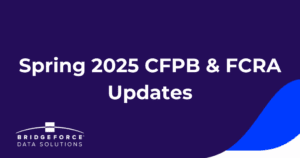It is well known in the world of credit reporting that businesses and lenders need to prioritize adherence to industry standards. Among these standards is Metro 2® compliance, a crucial framework for guiding accurate and timely reporting of consumer credit information.
Major credit bureaus and the Consumer Data Industry Association (CDIA) collaborated to create Metro 2® in response to the industry’s need for standardized reporting practices. These groups recognized the impact of credit data accuracy on financial decisions, from loan approvals to interest rates, and realized the importance of having a standardized format.
For an in-depth guide on Metro 2® formatting, the Credit Reporting Resource Guide (CRRG)® is a valuable, easy-reference resource. It provides the codes for compliance with requirements of the Fair Credit Billing Act (FCBA), Fair Credit Reporting Act (FCRA), Equal Credit Opportunity Act (ECOA), and applicable state laws.
In an increasingly interconnected financial landscape, it remains crucial, serving as a central piece for ensuring consistency, reliability, and fairness in credit reporting.
In this blog, we delve into the key components of Metro 2®, its importance in the financial landscape, and how to best meet and exceed compliance.
Key Components
According to the CDIA website, access to the Metro 2® format is limited to four key groups: companies that furnish data to Consumer Reporting Agencies (CRA), data processors who furnish data to the CRAs, software vendors who provide Metro 2® programming software, and CRAs that accept or transmit data in this Format. If you fall under one of these categories, you can access all the free resources the CDIA provides.
When it comes to compliance, formatting, and reporting, five key components should be kept in mind.
Compliance Requirements
With a 426-character format, several guidelines need to be followed to ensure proper reporting. Key requirements include proper formatting and monthly reporting of all accounts. They also include reporting all accounts with a final status code when they are ultimately paid or closed. These requirements ensure consistency and uniformity in credit reporting across the industry.
Data Accuracy
Accurate credit reporting is crucial for consumer lenders to make informed decisions. Lenders rely on these credit reports to assess consumers’ creditworthiness when approving loans, issuing credit cards, or setting interest rates. Metro 2® compliance mandates the accurate reporting of data elements, including account balances, payment history, account statuses (i.e., open, closed, delinquent), and identifying information (i.e., name, address, SSN). With the importance of reporting correct and accurate information, creditors must implement validation processes to ensure that the data reported to credit bureaus is accurate. This can include verifying information with internal records, third-party sources, or solutions before reporting it.
Timeliness of Reporting
Metro 2® compliance specifies deadlines for reporting credit information to credit bureaus. This helps ensure that consumers’ credit reports reflect the most current information available, enabling accurate credit assessments by lenders. In addition to the initial reporting, creditors are responsible for prompt updates to credit information in response to changes. This can include account closures, payments, or credit limit adjustments. On the same note, inaccuracies must be corrected promptly to maintain data integrity.
Security of Information
Protecting consumers’ financial data is paramount in the world of credit reporting. This requires creditors to implement robust security measures to safeguard information from unauthorized access, breaches, or identity theft. A common way for creditors to ensure maximum security is to utilize encryption techniques to secure data transmission and storage. Access controls such as password protection and restricted user permission can also limit access to authorized personnel only.
Dispute Resolution
The goal of compliance is to ensure that the consumer is protected through all steps of the credit reporting process. To support this, consumers have the right to dispute inaccurate information on their credit reports under the Fair Credit Reporting Act. Metro 2® compliance outlines procedures for handling disputes promptly and fairly.
Upon receiving a dispute, creditors must conduct a thorough investigation to verify the accuracy of the dispute information. This may involve reviewing account records, communicating with the consumer, and coordinating with credit bureaus to update the credit report accordingly.
Importance in the Financial Landscape
Going through the components of compliance is an excellent start to showing its importance in the consumer lender’s landscape. Ensuring consumers have accurate information on their credit reports helps the entire consumer lending ecosystem better assess an individual’s creditworthiness. Without the uniform reporting format of Metro 2®, it would be impossible to accurately share information from lender to lender.
The Role of the FCRA
The Fair Credit Reporting Act (FCRA) grants consumers specific rights regarding the accuracy of their credit information. Metro 2® compliance aligns with these provisions by establishing standardized procedures for handling consumer disputes and updating credit information promptly.
The FCRA grants specific rights and provides mechanisms for enforcing compliance with its provisions and remedies for consumers harmed by violations. In fact, for over 50 years, the Federal Trade Commission (FTC) has enforced the Fair Credit Reporting Act (FCRA). In 2010, the Consumer Financial Protection Bureau (CFPB) joined forces, bolstering oversight of FCRA compliance. The FTC maintains a close collaboration with the CFPB. Together, they act against entities that fall short of compliance standards. Additionally, Metro 2® compliance supports these efforts by providing consistent and standardized reporting practices that facilitate compliance monitoring and enforcement.
This uniform reporting instills trust and confidence among consumers to engage in financial activities across the entire ecosystem. When consumers have faith in their credit reports, they are more likely to borrow, lend, and make purchases using credit. The combination of these activities helps drive the country’s overall economic growth.
These standards help consumers and lenders’ willingness to rely on credit reports when making lending decisions. By adhering to compliance standards, creditors ensure the information reported to credit bureaus accurately reflects consumers’ credit histories. This mutual trust between organizations enables fair and informed lending decisions. This, in turn, reduces the risk of extending credit to individuals who may be unable to repay debts.
Additional Benefits of Compliance
Along with informing better decisions, Metro 2® compliance also enhances risk management practices for both lenders and financial institutions. Accurate credit reporting enables lenders to assess their credit risk more effectively, price loans appropriately, and allocate resources efficiently. This reduces the likelihood of financial losses due to default or delinquency.
Metro 2® compliance contributes to market efficiency by providing accurate and timely information to lenders, investors, and regulators. This transparency enhances market liquidity, reduces information asymmetry, and promotes competition, benefiting all involved.
Metro 2® compliance plays a critical role in promoting transparency, fairness, and efficiency in the overall financial landscape. By ensuring accurate credit reporting and compliance with industry standards, businesses, and financial institutions can foster trust, mitigate risk, and facilitate access to credit, thereby contributing to the growth and stability of the overall economy.
How to Best Meet and Exceed Compliance
All the above points are moot if you don’t understand how to best meet the compliance requirements enforced through Metro 2®, the CDIA, the FCRA, and the CFPB. Below are some strategies that lenders can implement to ensure they remain compliant.
Training and Education
The first step to ensuring Metro 2® compliance is properly training and educating staff members responsible for credit reporting. This can include understanding the Metro 2® format, reporting guidelines, dispute resolution processes, and data security protocols.
The CDIA is a great resource and offers various Metro 2® training at the beginner and advanced levels.
Robust Data Management
Implementing robust data management practices is another crucial step. This helps ensure the accuracy, completeness, and integrity of the reported credit information. This should involve regular data validation, reconciliation processes, and quality assurance checks to identify and rectify any discrepancies or errors.
Automated Reporting Systems and Internal Controls
Investing in automated systems that facilitate accurate and timely reporting of credit information is a great step to ensure maximum Metro 2® compliance. Tools like the Data Quality Scanner (DQS) are a great low-cost, low-IT solution that can achieve this. DQS does this by inspecting, benchmarking, and optimizing your credit bureau data for Metro 2® Compliance. Additionally, utilizing 380+ risk-ranked rules, DQS ensures accurate Metro 2® compliant credit reporting to mitigate your regulatory risks and decrease dispute rates by over 30%.
Compliance and Audit Reviews
Conducting regular compliance audits and reviews to assess the adherence to standards helps ensure proper procedures are in place. Engaging in internal or external audits with credit reporting experts can help provide recommendations for enhancing compliance efforts.
Staying Updated on Regulatory Changes
As the landscape shifts and consumers receive real-time credit report information, it is essential to stay on top of regulatory changes and guidance. This can be done by participating in industry forums, attending training sessions, and subscribing to regulatory updates from relevant authorities. It is also important to stay on top of the CRRG changes and implement them into data practices promptly.
Collaboration with Credit Bureaus
Working closely with Credit Bureaus and maintaining open communication can help ensure alignment with reporting requirements and expectations. Furnishers should do an annual audit with the credit bureaus to ensure FCRA compliance and uncover any persistent issues with Metro 2® reporting.
Continuous Improvement
With Metro 2®’s complex role in the financial landscape, continuous improvement is necessary to stay on top of compliance. Fostering a culture of growth within an organization by soliciting feedback from all parties, monitoring performance metrics, and implementing corrective actions as needed can help ensure compliance. Be sure to regularly review and update these credit reporting policies, procedures, and controls to reflect the evolving regulatory requirements and industry standards.
Conclusion
Metro 2® compliance is an important priority for lenders of all sizes and a crucial piece of the overall financial ecosystem. This means no corners can be cut to ensure compliance and the overall satisfaction of all parties involved.
If you are a lender looking for an automated solution to help with your compliance needs, reach out to one of our experts today.



